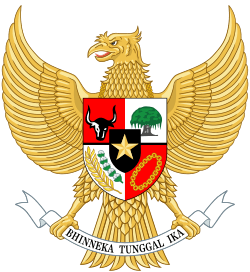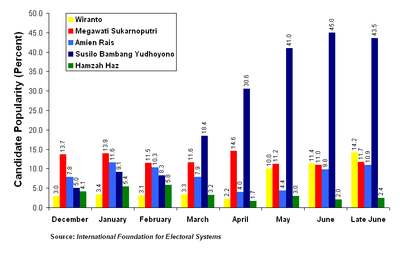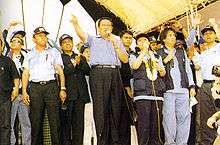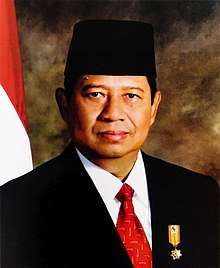2004 Indonesian presidential election
The first direct presidential election in Indonesia was held in two rounds on 5 July and 20 September 2004. Before a 2002 amendment to the Constitution of Indonesia, the President and Vice President were elected by the country's top legislative body, the People's Consultative Assembly (MPR).
| |||||||||||||||||||||||||||||
| |||||||||||||||||||||||||||||
_-_Provinces.svg.png) Results of the second round: the candidate with the majority of votes in each of the 32 provinces of Indonesia. Susilo Bambang Yudhoyono: blue; Megawati Sukarnoputri: red. | |||||||||||||||||||||||||||||
| |||||||||||||||||||||||||||||
 |
|---|
| This article is part of a series on the politics and government of Indonesia |
|
|
Under the new amendment, a candidate pair is elected into office after receiving more than 50% of the vote nationally with at least 2% of the vote in more than half of the provinces of Indonesia. If no pair receives the number of votes required, the election will continue into the second round with the pairs receiving the highest and second-highest number of votes. Further regulations set by the General Election Commission (KPU) state that each pair must be nominated by a political party or coalition of parties which received at least 5% of the popular vote or 3% of the seats to the People's Representative Council (DPR) in the April legislative election.
The incumbent president, Megawati Sukarnoputri, was sworn into office in 2001 after the legislature impeached and removed her predecessor, president Abdurrahman Wahid (often known as "Gus Dur"), from office. Megawati's re-election bid was challenged by four candidates, including incumbent vice president Hamzah Haz. In the first round, former cabinet member and retired general Susilo Bambang Yudhoyono received a plurality of the valid ballots submitted, followed by Megawati. Yudhoyono eventually defeated Megawati with 60.62% of the valid ballots in the second round. He was inaugurated as the sixth president of Indonesia on 20 October 2004.
Background
In the 1999 legislative election, the Indonesian Democratic Party of Struggle (PDI-P) won the most number of seats in the DPR and became the largest faction in the MPR, the legislative body responsible for electing the President. The PDI–P was led by Megawati Sukarnoputri, daughter of Sukarno, Indonesia's first president. Megawati's supporters had expected her to be elected president by the MPR, but she failed to reach out to parties other than the National Awakening Party (PKB). Her only opponent at the time was President B. J. Habibie, who came into office in May 1998, but he withdrew his candidacy after his accountability speech was rejected by the MPR. The PKB, which was led by Abdurrahman Wahid, the leader of Indonesia's largest Islamic organisation Nahdlatul Ulama (NU), had also pledged to support Megawati for President. However, it became clear that Megawati did not have enough votes to back her candidacy. Additionally, National Mandate Party (PAN) leader Amien Rais and his Central Axis (Indonesian: Poros Tengah), a coalition of Islamic and reform parties, began pushing for Abdurrahman's candidacy.[1]
Abdurrahman eventually won the MPR's presidential election, and Megawati was elected as Vice President.[2] As President, he repealed many of the laws enacted during the Suharto era that discriminated against Chinese Indonesians. Among these was the banning on the use of Chinese characters and display of images relating to Chinese culture. Following this act, many political parties began to reach out to Chinese Indonesians for their votes by displaying Chinese characters on campaign material.[3]
Following Abdurrahman's impeachment and removal from office by the MPR in July 2001, the legislative body elevated Megawati to the presidency. She would complete the remainder of Abdurrahman's five-year term, ending in October 2004.[2] During its 2002 annual session, the MPR added a series of amendments to the Constitution of Indonesia,[4] including the removal of the military's 38 appointed seats in the Assembly, and an amendment for direct election of the President and Vice President. This presidential election process would involve political parties nominating a presidential and vice-presidential ticket with the option of a runoff election.[5]
Candidates

In December 2003, the International Foundation for Electoral Systems (IFES) began a tracking survey in order to assess the popularity of potential candidates. The survey continued until the start of the first election round on 5 July and included thirteen possible candidates for president. The first IFES survey indicated that incumbent President Megawati Sukarnoputri received a plurality of the votes. However, by the time of the April 2004 legislative election, retired General Susilo Bambang Yudhoyono had taken the lead from Megawati after resigning from her cabinet in March. Other potential candidates included DPR Speaker Akbar Tanjung and Yogyakarta Sultan Hamengkubuwana X.[7]
The results of the legislative election determined which political parties were eligible to submit presidential tickets. Only parties which received at least 5% of the popular vote or 3% of seats (17 of 550 seats) in the DPR would be allowed to submit candidates. Parties that did not meet these criteria must join with other parties to meet at least one criterion. Seven political parties met these criteria: the Party of the Functional Groups (Golkar), the Indonesian Democratic Party of Struggle (PDI-P), the National Awakening Party (PKB), the United Development Party (PPP), the Democratic Party (PD), the Prosperous Justice Party (PKS), and the National Mandate Party (PAN). The PKS was the only party not to nominate candidates, but it later threw its support behind the PAN.[8]
The KPU announced the final list of candidates on 14 May. Following the announcement, all candidates were required to undergo medical screening. On 22 May, the Commission announced that the PKB's presidential candidate, former President Abdurrahman Wahid, had failed the eye test and was not allowed to enter in the election.[8] He initially told supporters not to vote for a presidential candidate on election day but decided to retract that statement after pressure from the party.[9][10]
Wiranto and Salahuddin Wahid
Golkar had won the April legislative election after losing to the PDI–P five years prior. The party nominated retired General Wiranto and Salahuddin Wahid, deputy chairman of the National Human Rights Commission, for its presidential ticket. The pair was assigned the number 1 for its ballot.[11]
Wiranto was an adjutant to former President Suharto in 1989–1993. During this time, he rapidly rose to the rank of full general and eventually became the head of the National Armed Forces.[12] When riots broke out throughout the country in 1998 against Suharto, he refused to take control in order to avoid the deaths of protesting university students. In 1999, as East Timor held an independence referendum, Wiranto was accused of having taken part in inciting violence among East Timorese along with several other officers; however, he was never issued an arrest warrant by Interpol.[13] Under President Abdurrahman Wahid, Wiranto served as the Coordinating Minister for Political and Security Affairs but was later dismissed. On 20 April 2004, the Golkar Convention voted to nominate him for president over DPR Speaker Akbar Tanjung in the second round of voting.[12]
On 9 May, Golkar selected Salahuddin Wahid (also known as Gus Sholah) as its vice-presidential candidate after an endorsement was made by his brother Abdurrahman.[14] Because Salahuddin was also a deputy chairman of the Central Board of Nahdlatul Ulama, many NU members criticised him for not adhering to the organisation's khittah, which affirmed the NU's status as a non-political organisation.[15] With this nomination, PKB leaders officially supported the Wiranto–Salahuddin pair for the election.[12]
Salahuddin's position on the human rights commission helped the reputation of Wiranto. However, because both candidates were of Javanese background, they were not expected to attract as many voters who were not Javanese.[12]
Megawati Sukarnoputri and Hasyim Muzadi
Incumbent President Megawati Sukarnoputri was the PDI–P's top nominee. She was joined by vice-presidential candidate Hasyim Muzadi, general chairman of Indonesia's largest Islamic organisation Nahdlatul Ulama (NU). The pair was assigned the number 2 for its ballot.[11]
According to a report released by the National Democratic Institute for International Affairs, Megawati has a "unique burden of being the only candidate in the race who is held responsible for the current situation most voters are unhappy with" although several other candidates have been members of her government.[16] However, the general discontent for her presidency was attributed mainly to the failure of the government to communicate Megawati's achievements rather than the state of the country itself.[17] The PDI–P came in second during the April legislative election with 18.5% of the votes, a reduction by almost half from the 33.7% it had received in 1999.[18]
Hasyim Muzadi had been mentioned as a possible running mate for Megawati as early as November 2003.[19] His candidacy was officially announced by Megawati on 6 May.[20] As Chairman of the Central Board of Nahdlatul Ulama, he was criticised by many NU members for not adhering to the organisation's khittah and the principle of political neutrality.[15] Muslim intellectual Nurcholish Madjid had called on him to step down from the position following the announcement of the candidacy.[21]
The two candidates' Javanese background were not expected to attract as many non-Javanese voters.[12] However, the candidates' status as civilians attracted those who did not favour candidates with a military background, and they also were expected to attract both secular and religious voters.[22]
Amien Rais and Siswono Yudohusodo
The PAN nominated Amien Rais, chairman of the MPR, as its presidential candidate. His running mate was Siswono Yudohusodo. The pair was assigned the number 3 for its ballot.[11]
Amien Rais had once served as the chairman of Muhammadiyah. However, despite leading the second-largest Islamic organisation in Indonesia, Amien established the PAN following the resignation of President Suharto as a party not based on religious affiliation. He became an influential figure in the early days of the reform period and was eventually elected to lead the MPR.[23] Among voters, he was seen as a candidate who had no association with the corruption that was endemic to the nation's government. Voters also saw him as an ambitious person and as one who was known for being an orator.[16] Amien's party had received 6.4% of the votes during the legislative election.[18]
On the other hand, Siswono Yudohusodo was a relative newcomer to the political scene. He served as the chairman of the Indonesian Farmers' Association (HKTI) and held ministerial positions during the later years of Suharto's presidency.[22] Siswono was the wealthiest of any candidate for president or vice president based on reports submitted by candidates to the Corruption Eradication Commission.[24]
Like Megawati and Hasyim, Amien and Siswono were also not expected to attract many non-Javanese voters. The pair was supported by the PKS, the seventh party which met the criteria to submit presidential and vice-presidential candidates but did not do so, and a number of smaller parties.[22]
Susilo Bambang Yudhoyono and Jusuf Kalla

The Democratic Party, supported by the Indonesian Justice and Unity Party (PKPI) and Crescent Star Party (PBB), nominated retired General Susilo Bambang Yudhoyono for its presidential candidate. He was later joined by Jusuf Kalla as running mate, and the pair was assigned the number 4 for its ballot.[11]
Susilo Bambang Yudhoyono has served in the cabinets of two previous administrations. While serving as Coordinating Minister for Political, Social and Security Affairs under Abdurrahman Wahid, he refused an order to declare a state of emergency that would have stopped the parliamentary process to impeach the President and was subsequently dismissed.[26] Yudhoyono was nominated for vice president after the MPR selected Megawati to succeed Abdurrahman Wahid, but he lost the election to PPP Chairman Hamzah Haz and DPR Speaker Akbar Tanjung.[27] He reprised his prior cabinet position in Megawati's administration but resigned on 1 March 2004 to join the race for the presidency.[22] The Democratic Party, established as a vehicle for Yudhoyono's political career by secular nationalists who saw the potential of his leadership,[27] received 7.45% of votes and 10% of DPR seats in the April legislative election.[18]
Yudhoyono's running mate was Jusuf Kalla, a wealthy Bugis businessman and member of Golkar who served as Coordinating Minister for People's Welfare under Megawati.[28] He mediated two separate peaceful resolutions to inter-religious conflicts between Christians and Muslims in his native Sulawesi in 2001 and Maluku in 2002.[29][30] Kalla joined Golkar's selection process for the party's presidential nominee in August 2003 but withdrew his candidacy days before the party convention the following April.[31][32] Several days later, he resigned his cabinet position and announced his alliance with Yudhoyono.[28] Kalla was also seen as a potential vice-presidential candidate for the incumbent Megawati.[33]
The combination brought together two men with very different backgrounds that added to the attractiveness of their ticket. Yudhoyono, who was raised in densely populated Java, is seen as more secular and has a military background. On the other hand, Kalla is a devout Muslim who grew up in the outer province of South Sulawesi and came from a civilian background.[28]
Hamzah Haz and Agum Gumelar
Incumbent Vice President Hamzah Haz was the presidential nominee of the PPP. He was joined by Minister of Transportation Agum Gumelar for the vice-presidential candidate. The pair was assigned the number 5 for its ballot.[11]
Hamzah Haz was elected vice president by the MPR after defeating DPR Speaker Akbar Tanjung when it removed President Abdurrahman Wahid from office in 2001. Although the BBC reported him once stating that "no woman was fit to head the world's leading Muslim nation", he came into office as the deputy to Indonesia's first female president. Haz served in the cabinet of President B. J. Habibie and was the first minister to resign from the Abdurrahman Wahid administration. He was accused of graft and nepotism but was never subjected to an investigation.[34] As Vice President, Haz had been a proponent of an amendment to the Constitution which would impose Islamic law on Muslims in the country. However, other political parties and the Islamic organisations Nahdlatul Ulama and Muhammadiyah opposed such amendment for fear of more extreme forms of Islam.[35]
A relatively unknown figure in the political scene, Agum Gumelar served as Minister of Transportation under Abdurrahman Wahid and Megawati.[28] In September 2003, Agum had recommended Susilo Bambang Yudhoyono or Jusuf Kalla as Megawati's running mate in the presidential election after predicting that the PDI–P would lose a significant number of votes in the April legislative election. However, both men eventually formed their own ticket, and Agum declined a vice-presidential candidate offer from Amien Rais in order to remain on the cabinet. He eventually accepted an offer from the PPP leadership to become Haz's running mate and resigned from Megawati's administration.[36]
Neither candidate was of Javanese origin; hence, they might have attracted constituencies of the outer provinces.[28]
Campaign
Corruption, collusion, and nepotism are the most consistently cited concerns among voters surveyed by the National Democratic Institute for International Affairs.[16]
Schedule
- 1 June 2004: All candidates sign the commitment of readiness to accept victory or defeat and to conduct a fair campaign.[37] Campaign period begins.[38]
- 1 July 2004: Campaign period ends.
- 5 July 2004: First round of voting.
- 20 September 2004: Second round of voting.
- 4 October 2004: Official second round results announced.[39]
- 20 October 2004: Inauguration of the President-elect and Vice President-elect.
Results
Former security minister Susilo Bambang Yudhoyono won the first round with 33% of the vote. Incumbent President Megawati Sukarnoputri was second with 26%, ahead of former armed forces chief Wiranto on 22%. Yudhoyono did not do as well as earlier opinion polls had suggested, while Megawati did better. This was attributed by Indonesian observers to Yudhoyono's lack of a nationwide party machine, such as Megawati's PDI-P and Wiranto's Golkar.
The counting of 113 million votes, already a massive task in such a large and diverse country, was made more difficult by problems with the ballot papers. Voters cast their ballots by making a hole in the ballot paper with a nail, above the photo of their preferred candidate. Because the ballot paper was handed to voters folded in half, many made the hole without unfolding the ballot, thus making two holes and invalidating their vote. Hundreds of thousands of these votes were invalidated before the General Election Committee (KPU) ruled that such ballots should be accepted.[40] This necessitated recounts in many places, slowing the count and raising fears of a disputed result.
Summary of the 5 July and 20 September 2004 Indonesian presidential election results
| Candidate | Running mate | Party | First round | Second round | ||
|---|---|---|---|---|---|---|
| Votes | % | Votes | % | |||
| Susilo Bambang Yudhoyono | Jusuf Kalla | Democratic Party (Partai Demokrat) | 39,838,184 | 33.57 | 69,266,350 | 60.62 |
| Megawati Sukarnoputri | Hasyim Muzadi | Indonesian Democratic Party – Struggle (Partai Demokrasi Indonesia Perjuangan) | 31,569,104 | 26.61 | 44,990,704 | 39.38 |
| Wiranto | Salahuddin Wahid | Party of the Functional Groups (Partai Golongan Karya) | 26,286,788 | 22.15 | ||
| Amien Rais | Siswono Yudohusodo | National Mandate Party (Partai Amanat Nasional) | 17,392,931 | 14.66 | ||
| Hamzah Haz | Agum Gumelar | United Development Party (Partai Persatuan Pembangunan) | 3,569,861 | 3.01 | ||
| Total | 118,656,868 | 100.00 | 114,257,054 | 100.00 | ||
| Source: Ananta, Arifin & Suryadinata 2005, pp. 80–83, 107 | ||||||
First round
_-_Provinces.svg.png)
Susilo Bambang Yudhoyono: dark blue; Megawati Sukarnoputri: red; Wiranto: yellow; Amien Rais: light blue.
Wiranto refused to accept the election results and petitioned the Constitutional Court. Wiranto and Salahuddin argued that, due to irregularities in ballot counting by the KPU, they had lost 5,434,660 votes from twenty-six provinces. Those ballots would have made the total popular vote for the pair higher than that for Megawati and Hasyim, putting the former pair instead of the latter in the second round. However, the Court ruled on 10 August that it found no irregularities and upheld the Commission's final count.[42]
Analysis
Second round
_-_Provinces.svg.png)
Susilo Bambang Yudhoyono: dark blue; Megawati Sukarnoputri: red.
Analysis
Reactions
- Indonesia: President Megawati Sukarnoputri said in a speech on Armed Forces Day, 5 October, "We have to show to the world we are a big nation. All components of the nation have to stick to the agreement we have struck that whoever is elected in the democratic election has to be accepted. We may have chosen differently. However, we had the same objective: that is to bring the nation to a better future."[44]
- Australia: Prime Minister John Howard planned to attend Yudhoyono's inauguration. Howard said, "I look forward to working closely with Dr. Yudhoyono and his new government to continue and extend the close cooperation between our two nations, particularly on counter-terrorism."[45]
- People's Republic of China: Politburo Standing Committee member Wu Guanzheng met with Yudhoyono on 13 October and conveyed congratulations from President Hu Jintao.[46]
Aftermath
| Wikinews has related news: |
Susilo Bambang Yudhoyono and Jusuf Kalla were sworn in as president and vice president on 20 October. It was the first Indonesian presidential inauguration to be attended by foreign leaders.[47] After a selection process that began on 15 October, the United Indonesia Cabinet was announced later following the inauguration. The 36-member cabinet was sworn in at the State Palace on 21 October.[48] The process of selecting candidates for Yudhoyono's cabinet was considered "decent, intelligent, and indecisive". While attempting to satisfy as many members as possible in his coalition of small parties, Yudhoyono created a cabinet that was neither quite as cohesive nor effective. However, Kalla soon became the party chairman of Golkar in late 2004 and turned the party's votes in the DPR to those in favour of the government, creating an effective bloc and leaving Megawati's PDI–P as the largest non-government party in the DPR.[49] Although the first one hundred days of Yudhoyono's administration saw continuing economic stability, it was overshadowed by the events of the Indian Ocean earthquake which occurred on 26 December. The earthquake triggered tsunamis that destroyed the coastline of the provinces of Aceh and North Sumatra and killed more than 200,000 people.[50]
Notes
- Thompson, Eric C. (December 1999). "Indonesia in Transition: the 1999 Presidential Elections" (PDF). National Bureau of Asian Research. Archived from the original (PDF) on 25 September 2012. Retrieved 20 June 2009. Cite journal requires
|journal=(help)CS1 maint: ref=harv (link) - Ananta, Arifin & Suryadinata 2005, p. 11
- Setiono, Benny G. (February 2003). "Etnis Tionghoa dan Partai Politik". Indonesia Media (in Indonesian). Archived from the original on 12 December 2008. Retrieved 20 June 2009.
- Langit, Richel (16 August 2002). "Indonesia's military: Business as usual". Asia Times Online. Retrieved 20 June 2009.
- Aglionby, John (11 August 2002). "Indonesia takes a giant step down the road to democracy". The Observer. Retrieved 10 June 2009.
- "Results from Wave XIV of Tracking Surveys" (PDF). International Foundation for Electoral Systems. 1 July 2004: 5. Archived from the original (PDF) on 29 November 2008. Retrieved 28 June 2009. Cite journal requires
|journal=(help)CS1 maint: ref=harv (link) - Ananta, Arifin & Suryadinata 2005, pp. 67–69
- Ananta, Arifin & Suryadinata 2005, p. 70
- "Gus Dur Tuntut KPU Rp 1 Triliun". Suara Merdeka (in Indonesian). 23 May 2004. Archived from the original on 16 July 2011. Retrieved 21 June 2009.
- "Gus Dur Batal Ajak Golput". Suara Merdeka (in Indonesian). 24 May 2004. Archived from the original on 30 June 2007. Retrieved 21 June 2009.
- "5 Pasang Capres-Cawapres Peroleh Nomor Urut". Kompas (in Indonesian). 24 May 2004. Archived from the original on 18 June 2004. Retrieved 10 September 2009.
- Ananta, Arifin & Suryadinata 2005, p. 71
- Chew, Amy (22 December 2003). "Wiranto emerges as 2004 contender". CNN. Retrieved 21 June 2009.
- "Golkar picks Gus Solah as VP candidate". The Jakarta Post. 10 May 2004. Archived from the original on 7 June 2011. Retrieved 28 June 2009.
- Fealy, Greg (2007). "The political contingency of reform-mindedness in Indonesia's Nahdlatul Ulama: interest politics and the Khittah". In Reid, Anthony & Gilsenan, Michael (eds.). Islamic Legitimacy in a Plural Asia. London: Routledge. p. 163. ISBN 0-415-45173-6.
- "The People's Voice: Presidential Politics and Voter Perspectives in Indonesia" (PDF). National Democratic Institute for International Affairs. June 2004. Archived from the original (PDF) on 29 November 2008. Retrieved 28 June 2009. Cite journal requires
|journal=(help)CS1 maint: ref=harv (link) - Ananta, Arifin & Suryadinata, p. 91
- Ananta, Arifin & Suryadinata 2005, p. 22
- Pereira, Derwin (7 November 2003). "Who will be Mega's running mate?". The Straits Times.
- "Megawati Memilih Hasyim Muzadi Sebagai Calon Wakil Presiden" (in Indonesian). Voice of America. 6 May 2004. Retrieved 28 June 2009.
- Arvian, Yandhrie (6 May 2004). "Cak Nur: Hasyim Muzadi Khianati Khitah NU". Tempo (in Indonesian). Archived from the original on 8 September 2008. Retrieved 28 June 2009.
- Ananta, Arifin & Suryadinata 2005, p. 72
- Ananta, Arifin & Suryadinata 2005, p. 12
- Sri Saraswati, Muninggar (3 July 2004). "Siswono the richest, Amien poorest candidate". The Jakarta Post. Archived from the original on 7 June 2011. Retrieved 29 June 2009.
- Ananta, Arifin & Suryadinata 2005, p. 56
- Ricklefs 2008, p. 395
- Ananta, Arifin & Suryadinata 2005, p. 23
- Ananta, Arifin & Suryadinata 2005, p. 73
- Muannas; Amir, Syarief (20 December 2001). "Deklarasi Malino Mengakhiri Pertikaian di Poso". Tempo (in Indonesian). Archived from the original on 30 November 2004. Retrieved 10 September 2009.
- Hadi, Syamsul (2007). Disintegrasi Pasca Orde Baru: Negara, Konflik Lokal dan Dinamika Internasional (in Indonesian). Jakarta: Centre for International Relations Studies. p. 179. ISBN 979-461-624-9.
- "Wiranto dan Kalla Maju, Agum Gumelar Mundur". Kompas (in Indonesian). 7 August 2003. Archived from the original on 8 August 2003. Retrieved 10 September 2009.
- "Kalla Mundur Sebelum Konvensi". Radar Sulteng (in Indonesian). 16 April 2004. Archived from the original on 8 October 2011. Retrieved 10 September 2009.
- "Blow to Megawati re-election bid". BBC. 19 April 2004. Retrieved 10 September 2009.
- "Profile: Hamzah Haz". BBC. 26 July 2001. Retrieved 12 September 2009.
- Ricklefs 2008, p. 400
- Cahyana, Ludhi; Parlan, Tri Mariyani. "Hamzah Haz dan Agum Gumelar" (in Indonesian). Institute for the Studies on Free Flow of Information. Archived from the original on 21 July 2011. Retrieved 12 September 2009.
- "Semua Calon Siap Menang dan Kalah". Kompas (in Indonesian). 2 June 2004. Archived from the original on 22 June 2004. Retrieved 10 September 2009.
- "Jadwal Kampanye Pemilu Presiden". Tempo (in Indonesian). 27 May 2004. Archived from the original on 23 June 2009. Retrieved 21 June 2009.
- Purwanto (4 October 2004). "Presiden Terpilih Ditetapkan Sore Ini". Tempo (in Indonesian). Archived from the original on 14 June 2009. Retrieved 21 June 2009.
- Harsono, Andreas (8 July 2004). "Megawati Crawls In While Wiranto Cries Foul". The Irrawaddy. Archived from the original on 11 August 2010. Retrieved 21 June 2009.
- Compiled from Ananta, Arifin & Suryadinata 2005, table 3.3
- Ananta, Arifin & Suryadinata 2005, p. 69
- Compiled from Ananta, Arifin & Suryadinata 2005, table 4.3
- Moore, Matthew (6 October 2004). "Megawati still keeping Yudhoyono on hold". The Sydney Morning Herald. Fairfax Media. Retrieved 20 June 2009.
- Forbes, Mark (15 October 2004). "PM to see new leader sworn in". The Age. Fairfax Media. Retrieved 20 June 2009.
- "Senior Chinese leader meets Indonesia's president-elect". Xinhua News Agency. 14 October 2004. Retrieved 20 June 2009.
- Ananta, Arifin & Suryadinata 2005, p. 121
- Ananta, Arifin & Suryadinata 2005, p. 128
- Ricklefs 2008, pp. 404–405
- Ananta, Arifin & Suryadinata 2005, pp. 132–133
References
- Ananta, Aris; Arifin, Evi Nurvidya & Suryadinata, Leo (2005). Emerging Democracy in Indonesia. Singapore: Institute of Southeast Asian Studies. ISBN 978-981-230-322-6.CS1 maint: ref=harv (link)
- Hadiwinata, Bob S. (2006). The 2004 Parliamentary and Presidential Elections in Indonesia. Between Consolidation and Crisis: Elections and Democracy in Five Nations in Southeast Asia. Berlin: Lit. pp. 85–146.
- Koirudin (2004). Kilas Balik Pemilihan Presiden 2004 (in Indonesian). Yogyakarta: Pustaka Pelajar. ISBN 979-3721-11-1.CS1 maint: ref=harv (link)
- Ricklefs, M. C. (2008). A History of Modern Indonesia since c. 1200 (4th ed.). Stanford, CA: Stanford University Press. ISBN 0-8047-6130-2.CS1 maint: ref=harv (link)

.jpg)

